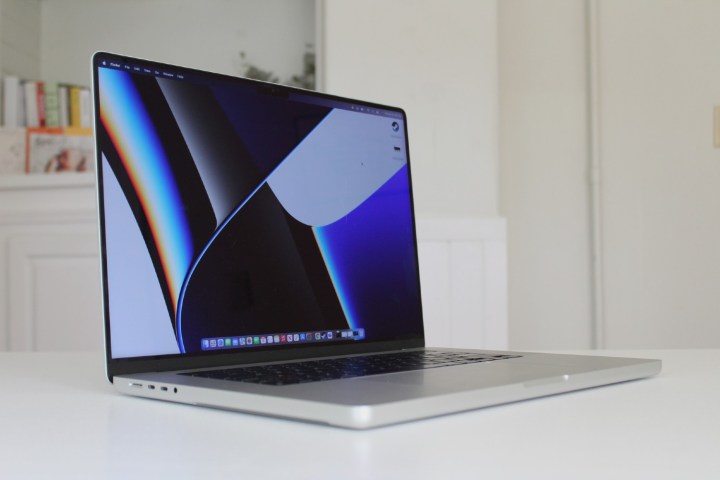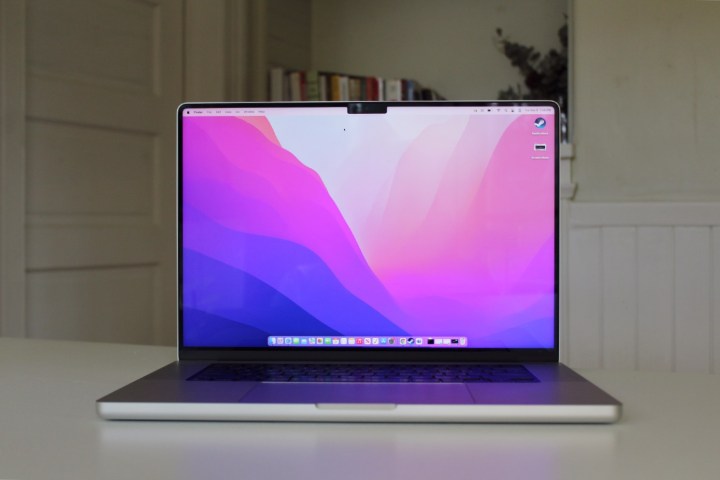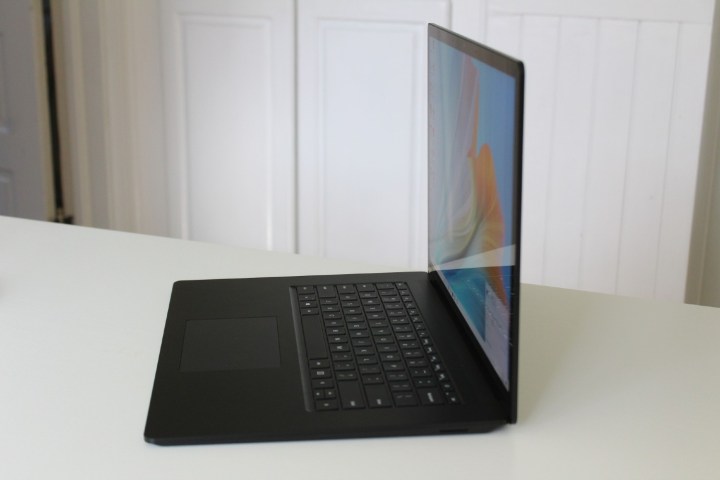Apple recently underwent one of its most significant laptop updates in decades, switching all its machines from Intel CPUs to its own M1 processors. The MacBook Pro 16 now offers a choice between the Apple M1 Pro and M1 Max, two high-speed and efficient CPUs. Microsoft’s highest-end clamshell laptop, the Surface Laptop 4 15, retains its AMD and Intel CPUs and much of its design from its previous generation.
Both are excellent laptops, but the new MacBook Pro 16 is the more significant update. The question is, how do they measure up?
Specs
| Microsoft Surface Laptop 4 15 | Apple MacBook Pro 16 | |
| Dimensions | 13.4 inches x 9.6 inches x 0.58 inches | 14.01 inches x 9.77 inches x 0.66 inches |
| Weight | 3.4 pounds | 4.8 pounds |
| Processor | Intel Core i7-1185G7 AMD Ryzen 7 4980U Surface Edition |
Apple M1 Pro Apple M1 Max |
| Graphics | Intel Iris Xe AMD Radeon Graphics |
Integrated |
| RAM | 8GB, 16GB, 32GB | 16GB, 32GB, 64GB (M1 Max) |
| Display | 15-inch 3:2 IPS 2,256 x 1,504 | 16.2-inch Liquid Retina XDR 3,456 x 2,234 |
| Storage | 256GB, 512GB, 1TB solid-state drive (SSD) | 512GB, 1TB, 2TB, 4TB, 8TB |
| Touch | Yes | No |
| Ports | 1 x USB-C 3.2 1 x USB-A 3.2 1 x Surface Connect 1 x 3.5mm audio jack |
3 x USB-C 4 with Thunderbolt 4 1 x HDMI 2.0 1 x 3.5mm audio jack 1 x SD Card reader |
| Wireless | Wi-Fi 6 and Bluetooth 5.0 | Wi-Fi 6 and Bluetooth 5.0 |
| Webcam | 720p | 1080p |
| Operating system | Windows 11 Home | MacOS |
| Battery | 47 watt-hour | 100 watt-hour |
| Price | $1,000+ | $2,499+ |
| Rating | 3 out of 5 stars | 5 out of 5 stars |
Design

We’ll set aside the question of operating systems. If you’re choosing between these two laptops, then you’re willing to consider either Windows 11 or MacOS Monterey. If either one of those operating systems doesn’t appeal to you, then your choice is already made.
Looking at the hardware, you’ll find that these are two very different machines. The Surface Laptop 4 is meant to be a very thin and light laptop, coming in at 0.58 inches and weighing just 3.4 pounds — both of which are excellent given its 15-inch 3:2 display. The MacBook Pro 16 represents a step in the opposite direction for Apple, which was also striving for thin and light laptops for years. In contrast, the MacBook Pro 16 got thicker and heavier in this version, up to 0.66 inches and 4.8 pounds. It has a 16.2-inch 16:10 display, so it was bound to be a bigger laptop. The thing is, it’s only half an inch wider and only 0.17 inches deeper, meaning it’s not much larger than the Surface Laptop 4.
Apple finally incorporated thinner bezels to fit into a smaller — if still thicker and heavier — chassis. We’ll note that there’s a notch in the MacBook Pro 16 display that’s similar to the one you’ll find in an iPhone, but that’s a trifling concern overall.
You’ll find that both laptops are well built, sporting CNC machined aluminum bodies that resist all bending, twisting, and flexing. Both hinges can be opened with one hand while holding the displays firmly in place. These are two of the best-made laptops around, and neither has an advantage.
In terms of their aesthetics, both are attractive laptops. The Surface Laptop 4 is a streamlined design that comes in two colors, Platinum and Matte Black. It sports simple lines and angles and is quite minimalist in its appearance. The MacBook Pro 16 is similar. It, too, has simple angles and lines and, in fact, is a bit boxy — although its rounded corners smooth things out a bit. Overall, the MacBook Pro 16 is more conservatively elegant, while the Surface Laptop 4 is slightly more extravagant.
The MacBook Pro 16 has the best keyboard you can buy on a laptop today. It doesn’t have tons of travel, but Apple has tuned the scissor switches to perfection — they’re light yet snappy and guaranteed to be precise without causing fatigue over long typing sessions. The Surface Laptop 4’s keyboard is also very good, being deeper and enjoying snappy mechanisms, but it can’t quite keep up. The same holds with the touchpads. The Surface Laptop 4 has a good touchpad that’s large enough to be comfortable and supports all of Windows 11’s multitouch gestures. But the MacBook Pro 16’s touchpad is enormous, and Apple has perfected its haptic feedback engine to create “clicks” that mimic physical buttons. The Surface Laptop 4’s only input advantage is that its display is touch-enabled while the MacBook Pro 16’s is not, and it also supports Microsoft’s Surface Pen.
Another positive step backward in the MacBook Pro 16’s design is in its connectivity. Where the previous generations had just USB-C with Thunderbolt support, the newest model has a full-size HDMI 2.0 port and an SD card reader to go with its three USB-C with Thunderbolt 4 ports. The Surface Laptop 4 has just one USB-C 3.2 port (no Thunderbolt 4 support), a USB-A port, and the Surface Connect port for power and to connect to Microsoft’s proprietary dock. Both offer Wi-Fi 6 and Bluetooth 5.0. The MacBook Pro 16 has emerged as a real connectivity winner, although you’ll still need a dongle for legacy USB-A devices.
Performance

The Surface Laptop 4 comes in two configurations: Intel’s four-core/eight-thread Core i7-1185G7 or AMD’s eight-core/16-thread Ryzen 7 4980U Surface Edition. The MacBook Pro 16 can be equipped with either the Apple M1 Pro or the Apple M1 Max, both representing the second generation of Apple’s M1 CPU. Apple’s options are a bit more complicated, with the M1 Pro 10 offering CPU cores and 16 GPU cores and the M1 Max sporting 10 CPU cores and either 24 or 32 GPU cores. We tested the Surface Laptop 4 with the AMD Ryzen chip and the MacBook Pro 16 with the M1 Pro.
In terms of raw performance, it’s not even close. The MacBook Pro 16 obliterated the Surface Laptop 4 in our benchmarks. In Geekbench 5, for example, the Surface Laptop 4 scored 1,016 in the single-core test and 6,658 in the multi-core test, compared to the MacBook Pro 16 at 1,773 and 12,605. In Cinebench R23, the Surface Laptop 4 scored 1,137 and 5,881 compared to the MacBook Pro 16 at 1,531 and 12,343. In the Pugetbench benchmark that runs on Adobe Premiere Pro, the Surface Laptop 4 scored 163 while the MacBook Pro 16 hit a phenomenal 956.
The MacBook Pro 16 is an incredibly fast laptop, and it beats out most Intel- and AMD-based Windows laptops. You have to equip a very fast 45-watt Intel CPU to even come close to M1 Pro (not to mention M1 Max) performance levels. Suffice it to say, the Surface Laptop 4 doesn’t play in these leagues. Even in gaming, the MacBook Pro 16 will be a much faster laptop.
Display

The Surface Laptop 4 has a 15-inch IPS display in the productivity-friendly 3:2 aspect ratio and runs at a resolution of 2,256 x 1,504. The MacBook Pro 16 has a 16.2-inch Liquid Retina XDR display at 16:10 and a 3,456 x 2,234 resolution. As with performance, the MacBook Pro 16 is in a completely different league.
The MacBook Pro 16’s display was brighter at 475 nits compared to 378 nits, it had higher contrast at an OLED-like 475,200:1 compared to just 970:1, its colors were wider at 90% of AdobeRGB and 100% of sRGB compared to 73% and 97%, and it was more accurate at a DeltaE of 1.04 (less than 1.0 is considered excellent) compared to 1.44. It’s also significantly higher resolution, and it’s larger.
The Surface Laptop 4’s display is fine for productivity work. In fact, it’s a very good display. But it can’t hold a candle to the MacBook Pro 16’s superior display that will thrill creative types as well.
Portability

The Surface Laptop 4 is slightly smaller in width and depth, and it’s quite a bit thinner and lighter. The MacBook Pro 16 isn’t nearly as portable.
However, the MacBook Pro 16 has twice the battery capacity and sports the more efficient M1 Pro CPU. It lasted for 18.5 hours in our web browsing test, while the Surface Laptop 4 made it to just 13.5 hours. Once again, the MacBook Pro 16 beats the Surface Laptop 4 handily. It will last for a couple of days on a single charge, while you’ll be plugging in Microsoft’s laptop after a single day’s use.
The Apple MacBook Pro 16 is expensive but well worth it
The Surface Laptop 4 has a starting price of $1,300, configured with a Ryzen 7 4980U CPU, 8GB of RAM, and a 256GB SSD. At the high end, you’ll spend $2,400 for an Intel Core i7, 32GB of RAM, and a 1TB SSD. It’s a premium laptop, but its high-end price is still less than the MacBook Pro 16’s entry-level.
Yes, that’s right, the MacBook Pro 16 starts at $2,499 for an Apple M1 Pro CPU, 16GB of RAM, and a 512GB SSD. Max it out with an M1 Max chip, 64GB of RAM, and a whopping 8TB SSD, and you’ll spend $6,099. It’s a stunningly expensive laptop.
There’s really no comparison. Again, these are both great laptops, but the MacBook Pro 16 is in a different class entirely. You’re going to spend a lot more money on it, but you’ll find the investment well worth it.



